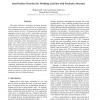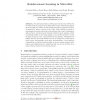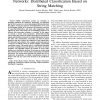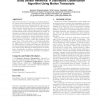76 search results - page 4 / 16 » Modeling and recognition of actions through motor primitives |
IROS
2007
IEEE
14 years 3 days ago
2007
IEEE
— Affordances represent the behavior of objects in terms of the robot’s motor and perceptual skills. This type of knowledge plays a crucial role in developmental robotic system...
CVPR
2012
IEEE
11 years 8 months ago
2012
IEEE
This paper addresses recognition of human activities with stochastic structure, characterized by variable spacetime arrangements of primitive actions, and conducted by a variable ...
ICANN
2005
Springer
13 years 11 months ago
2005
Springer
For this special session of EU projects in the area of NeuroIT, we will review the progress of the MirrorBot project with special emphasis on its relation to reinforcement learning...
TITB
2010
13 years 16 days ago
2010
Mobile sensor-based systems are emerging as promising platforms for healthcare monitoring. An important goal of these systems is to extract physiological information about the subj...
IPSN
2010
Springer
13 years 7 months ago
2010
Springer
Body sensor networks are emerging as a promising platform for remote human monitoring. With the aim of extracting bio-kinematic parameters from distributed body-worn sensors, thes...




